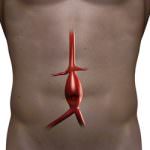An abdominal aortic aneurysm is a swelling of the aorta – the main blood vessel that leads away from the heart, down through the abdomen to the rest of the body. The diameter of this aorta varies depending on age and sex, but a diameter of 3cm or more is generally classified as an abdominal aortic aneurysm. If left untreated, it causes progressive weakening of the aorta wall until it breaks and leads to a life-threatening hemorrhage. If the aorta ruptures, the result is often fatal, even if emergency surgery is performed. Out of those patients that do reach a hospital in time, about 40% receiving open surgery and 20% receiving endovascular surgery die.
Because most abdominal aortic aneurysms are asymptomatic – about three out of four patients do not experience any symptoms – screening via ultrasound can help identify, monitor, and treat an aneurysm before a rupture occurs. Aneurysms that are detected by screening early on can be surgically repaired, substantially increasing the patient’s chance of survival.
There are various factors that can contribute to an abdominal aortic aneurysm. Some are hereditary, while others are related to lifestyle. These factors include:
- Atherosclerosis (plaque buildup in the artery)
- Genetic disorders
- Hypertension (high blood pressure)
- Smoking
Risk increases with age, and is highest in men over the age of 65.
An ultrasound is a safe and painless test that is used in the detection – finding and measuring – of an abdominal aortic aneurysm. Screening is scientifically proven to reduce the frequency of ruptures and aims to lower the risk of death. Just one screening can end up saving your life, so schedule your appointment for an abdominal aorta ultrasound today.










No comments yet.